Health Variations Case Study: Urosepsis Analysis, WSU
VerifiedAdded on 2022/11/29
|8
|2294
|341
Case Study
AI Summary
This case study analyzes the urosepsis of a 75-year-old male, Mr. Kirkman, who presented with symptoms of a urinary tract infection (UTI). The assignment delves into the pathogenesis of urosepsis, explaining how bacterial infection leads to sepsis, and the patient's clinical manifestations like burning sensation, abdominal pain, and fever. It analyzes the role of factors like age, catheter use, and prior UTIs in the progression of the disease. The study then focuses on an appropriate nursing strategy, specifically, the importance of effective breathing patterns, and provides evidence-based rationale. Finally, it critically examines Mr. Kirkman's arterial blood gas (ABG) results, interpreting the abnormal findings and linking them to the underlying pathophysiology, including respiratory and metabolic imbalances caused by sepsis and its impact on oxygenation and acid-base balance. The assignment demonstrates the student's ability to integrate clinical knowledge with critical analysis.

Running head: UROSEPSIS 1
UROSEPSIS
Student’s Name
Institutional Affiliation
Course
Instructor
Date
UROSEPSIS
Student’s Name
Institutional Affiliation
Course
Instructor
Date
Paraphrase This Document
Need a fresh take? Get an instant paraphrase of this document with our AI Paraphraser

UROSEPSIS 2
Introduction
The paper will critically analyse the case scenario of Mr Kirkman who is 75 years
older with a diagnosis of Urinary Tract Infection. He presented to the ED with complaints of
burning sensation when urinating and lower abdominal pain which radiated to his right flank.
Relating to the clinical manifestations of Mr Kirman, the paper will analyse the pathogenesis.
Secondly, the paper will discuss one nursing strategy while underpinning the evidence base.
Thirdly, the paper will analyse the results of the Arterial Blood Gas in relation the underlying
pathogenesis.
Pathogenesis of Urinary Tract Infection With Sepsis (Urosepsis)
Infection of the bladder results from the invasion and overgrowth of bacteria
(Escherichia coli (E. coli), in the urinary bladder. The bacteria take hold in the tube draining
urine to the bladder via the kidney. The condition is referred to as Urinary Tract Infection
(UTI). The UTI may affect the entire urinary system including the ureters, kidneys, urethra,
and urinary bladder. UTI is commonly caused by bacteria which enter the urethra via the
genital area and the immune system of the body tries to fight it back to prevent its
multiplication. UTI can also be caused by a fungal infection whereby the fungus enters the
urinary tract via the blood stream (Flores-Mireles, Walker, Caparon, & Hultgren, 2015).
The bacteria enter the urinary tract in multiple ways including poor personal hygiene,
sexual contact, or pre-existing condition of the urinary bladder. The spread of the bacterial
into the urinary bladder results to an infection. If the UTI stays for some time without being
treated or managed, the patient developed other complications especially sepsis. Sepsis as a
result of a UTI is known as urosepsis. Other factors which increase the risk of development
of UTI and urosepsis include diabetes, immunosuppression, age of more than 65 years, past
history of urinary tract infections, and corticosteroid treatment (Peach, Garvan, Garvan, &
Cimiotti, 2016). From the case scenario, Mr Kirman has a past history of UTI and an in-
Introduction
The paper will critically analyse the case scenario of Mr Kirkman who is 75 years
older with a diagnosis of Urinary Tract Infection. He presented to the ED with complaints of
burning sensation when urinating and lower abdominal pain which radiated to his right flank.
Relating to the clinical manifestations of Mr Kirman, the paper will analyse the pathogenesis.
Secondly, the paper will discuss one nursing strategy while underpinning the evidence base.
Thirdly, the paper will analyse the results of the Arterial Blood Gas in relation the underlying
pathogenesis.
Pathogenesis of Urinary Tract Infection With Sepsis (Urosepsis)
Infection of the bladder results from the invasion and overgrowth of bacteria
(Escherichia coli (E. coli), in the urinary bladder. The bacteria take hold in the tube draining
urine to the bladder via the kidney. The condition is referred to as Urinary Tract Infection
(UTI). The UTI may affect the entire urinary system including the ureters, kidneys, urethra,
and urinary bladder. UTI is commonly caused by bacteria which enter the urethra via the
genital area and the immune system of the body tries to fight it back to prevent its
multiplication. UTI can also be caused by a fungal infection whereby the fungus enters the
urinary tract via the blood stream (Flores-Mireles, Walker, Caparon, & Hultgren, 2015).
The bacteria enter the urinary tract in multiple ways including poor personal hygiene,
sexual contact, or pre-existing condition of the urinary bladder. The spread of the bacterial
into the urinary bladder results to an infection. If the UTI stays for some time without being
treated or managed, the patient developed other complications especially sepsis. Sepsis as a
result of a UTI is known as urosepsis. Other factors which increase the risk of development
of UTI and urosepsis include diabetes, immunosuppression, age of more than 65 years, past
history of urinary tract infections, and corticosteroid treatment (Peach, Garvan, Garvan, &
Cimiotti, 2016). From the case scenario, Mr Kirman has a past history of UTI and an in-
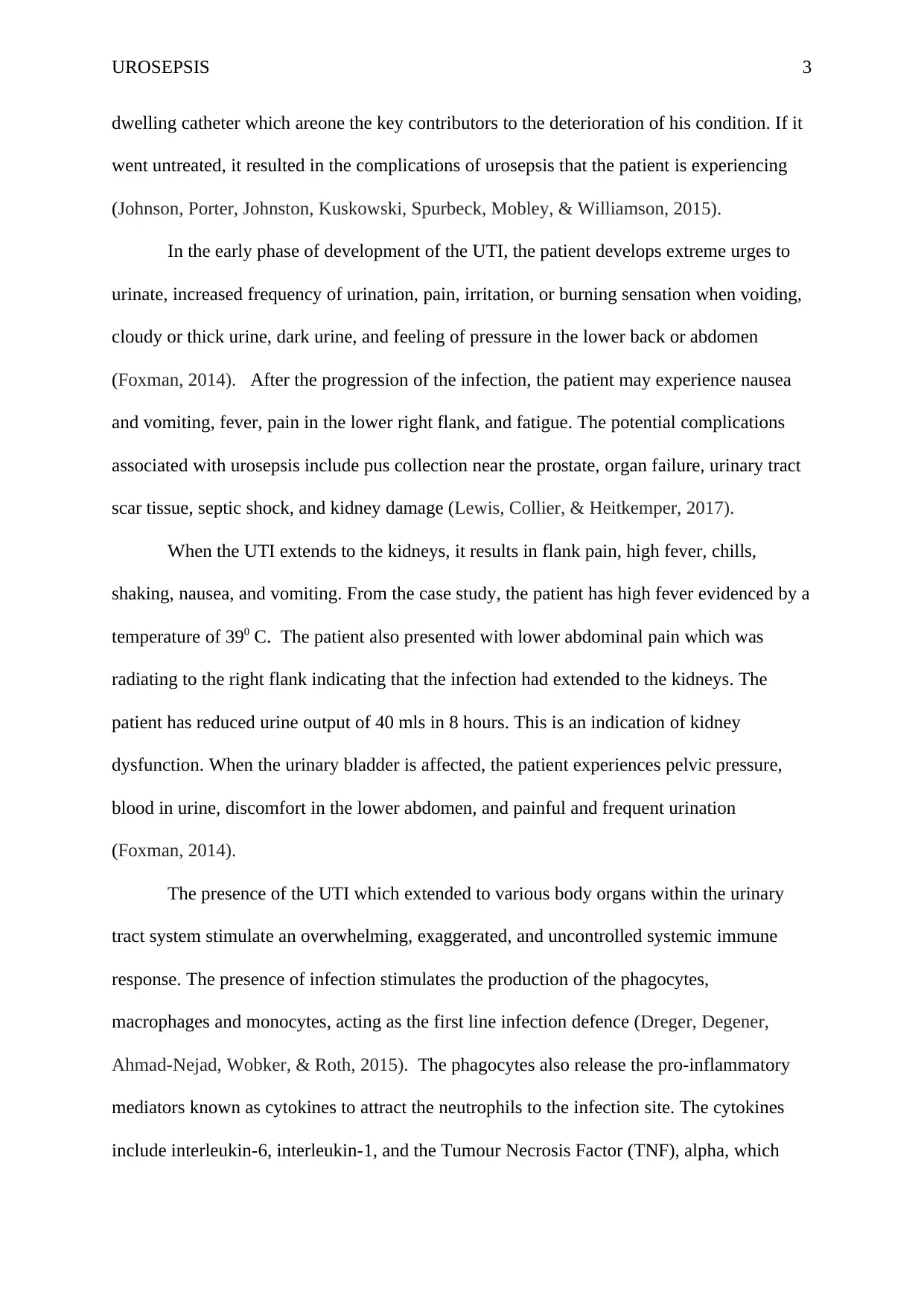
UROSEPSIS 3
dwelling catheter which areone the key contributors to the deterioration of his condition. If it
went untreated, it resulted in the complications of urosepsis that the patient is experiencing
(Johnson, Porter, Johnston, Kuskowski, Spurbeck, Mobley, & Williamson, 2015).
In the early phase of development of the UTI, the patient develops extreme urges to
urinate, increased frequency of urination, pain, irritation, or burning sensation when voiding,
cloudy or thick urine, dark urine, and feeling of pressure in the lower back or abdomen
(Foxman, 2014). After the progression of the infection, the patient may experience nausea
and vomiting, fever, pain in the lower right flank, and fatigue. The potential complications
associated with urosepsis include pus collection near the prostate, organ failure, urinary tract
scar tissue, septic shock, and kidney damage (Lewis, Collier, & Heitkemper, 2017).
When the UTI extends to the kidneys, it results in flank pain, high fever, chills,
shaking, nausea, and vomiting. From the case study, the patient has high fever evidenced by a
temperature of 390 C. The patient also presented with lower abdominal pain which was
radiating to the right flank indicating that the infection had extended to the kidneys. The
patient has reduced urine output of 40 mls in 8 hours. This is an indication of kidney
dysfunction. When the urinary bladder is affected, the patient experiences pelvic pressure,
blood in urine, discomfort in the lower abdomen, and painful and frequent urination
(Foxman, 2014).
The presence of the UTI which extended to various body organs within the urinary
tract system stimulate an overwhelming, exaggerated, and uncontrolled systemic immune
response. The presence of infection stimulates the production of the phagocytes,
macrophages and monocytes, acting as the first line infection defence (Dreger, Degener,
Ahmad-Nejad, Wobker, & Roth, 2015). The phagocytes also release the pro-inflammatory
mediators known as cytokines to attract the neutrophils to the infection site. The cytokines
include interleukin-6, interleukin-1, and the Tumour Necrosis Factor (TNF), alpha, which
dwelling catheter which areone the key contributors to the deterioration of his condition. If it
went untreated, it resulted in the complications of urosepsis that the patient is experiencing
(Johnson, Porter, Johnston, Kuskowski, Spurbeck, Mobley, & Williamson, 2015).
In the early phase of development of the UTI, the patient develops extreme urges to
urinate, increased frequency of urination, pain, irritation, or burning sensation when voiding,
cloudy or thick urine, dark urine, and feeling of pressure in the lower back or abdomen
(Foxman, 2014). After the progression of the infection, the patient may experience nausea
and vomiting, fever, pain in the lower right flank, and fatigue. The potential complications
associated with urosepsis include pus collection near the prostate, organ failure, urinary tract
scar tissue, septic shock, and kidney damage (Lewis, Collier, & Heitkemper, 2017).
When the UTI extends to the kidneys, it results in flank pain, high fever, chills,
shaking, nausea, and vomiting. From the case study, the patient has high fever evidenced by a
temperature of 390 C. The patient also presented with lower abdominal pain which was
radiating to the right flank indicating that the infection had extended to the kidneys. The
patient has reduced urine output of 40 mls in 8 hours. This is an indication of kidney
dysfunction. When the urinary bladder is affected, the patient experiences pelvic pressure,
blood in urine, discomfort in the lower abdomen, and painful and frequent urination
(Foxman, 2014).
The presence of the UTI which extended to various body organs within the urinary
tract system stimulate an overwhelming, exaggerated, and uncontrolled systemic immune
response. The presence of infection stimulates the production of the phagocytes,
macrophages and monocytes, acting as the first line infection defence (Dreger, Degener,
Ahmad-Nejad, Wobker, & Roth, 2015). The phagocytes also release the pro-inflammatory
mediators known as cytokines to attract the neutrophils to the infection site. The cytokines
include interleukin-6, interleukin-1, and the Tumour Necrosis Factor (TNF), alpha, which
⊘ This is a preview!⊘
Do you want full access?
Subscribe today to unlock all pages.

Trusted by 1+ million students worldwide
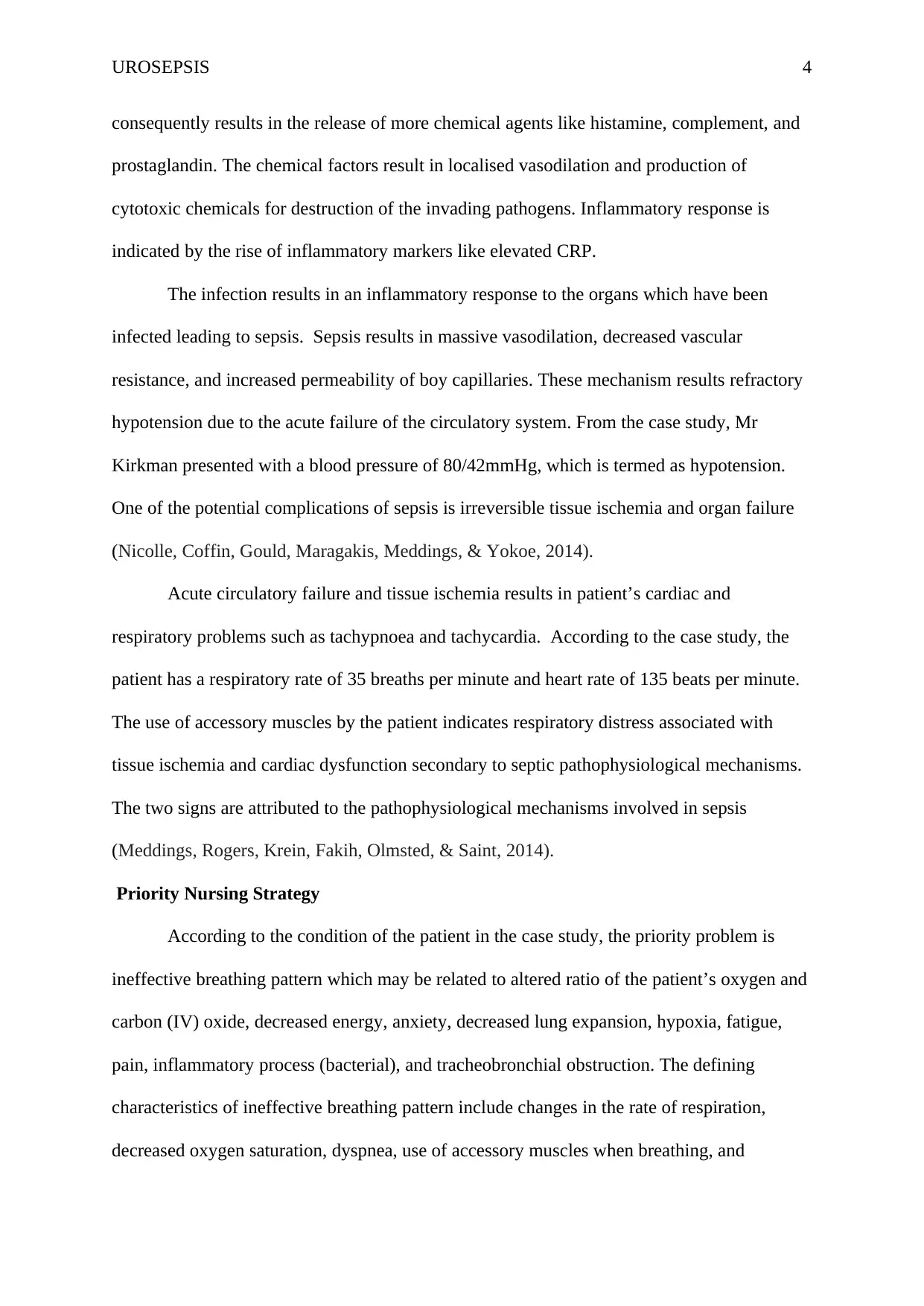
UROSEPSIS 4
consequently results in the release of more chemical agents like histamine, complement, and
prostaglandin. The chemical factors result in localised vasodilation and production of
cytotoxic chemicals for destruction of the invading pathogens. Inflammatory response is
indicated by the rise of inflammatory markers like elevated CRP.
The infection results in an inflammatory response to the organs which have been
infected leading to sepsis. Sepsis results in massive vasodilation, decreased vascular
resistance, and increased permeability of boy capillaries. These mechanism results refractory
hypotension due to the acute failure of the circulatory system. From the case study, Mr
Kirkman presented with a blood pressure of 80/42mmHg, which is termed as hypotension.
One of the potential complications of sepsis is irreversible tissue ischemia and organ failure
(Nicolle, Coffin, Gould, Maragakis, Meddings, & Yokoe, 2014).
Acute circulatory failure and tissue ischemia results in patient’s cardiac and
respiratory problems such as tachypnoea and tachycardia. According to the case study, the
patient has a respiratory rate of 35 breaths per minute and heart rate of 135 beats per minute.
The use of accessory muscles by the patient indicates respiratory distress associated with
tissue ischemia and cardiac dysfunction secondary to septic pathophysiological mechanisms.
The two signs are attributed to the pathophysiological mechanisms involved in sepsis
(Meddings, Rogers, Krein, Fakih, Olmsted, & Saint, 2014).
Priority Nursing Strategy
According to the condition of the patient in the case study, the priority problem is
ineffective breathing pattern which may be related to altered ratio of the patient’s oxygen and
carbon (IV) oxide, decreased energy, anxiety, decreased lung expansion, hypoxia, fatigue,
pain, inflammatory process (bacterial), and tracheobronchial obstruction. The defining
characteristics of ineffective breathing pattern include changes in the rate of respiration,
decreased oxygen saturation, dyspnea, use of accessory muscles when breathing, and
consequently results in the release of more chemical agents like histamine, complement, and
prostaglandin. The chemical factors result in localised vasodilation and production of
cytotoxic chemicals for destruction of the invading pathogens. Inflammatory response is
indicated by the rise of inflammatory markers like elevated CRP.
The infection results in an inflammatory response to the organs which have been
infected leading to sepsis. Sepsis results in massive vasodilation, decreased vascular
resistance, and increased permeability of boy capillaries. These mechanism results refractory
hypotension due to the acute failure of the circulatory system. From the case study, Mr
Kirkman presented with a blood pressure of 80/42mmHg, which is termed as hypotension.
One of the potential complications of sepsis is irreversible tissue ischemia and organ failure
(Nicolle, Coffin, Gould, Maragakis, Meddings, & Yokoe, 2014).
Acute circulatory failure and tissue ischemia results in patient’s cardiac and
respiratory problems such as tachypnoea and tachycardia. According to the case study, the
patient has a respiratory rate of 35 breaths per minute and heart rate of 135 beats per minute.
The use of accessory muscles by the patient indicates respiratory distress associated with
tissue ischemia and cardiac dysfunction secondary to septic pathophysiological mechanisms.
The two signs are attributed to the pathophysiological mechanisms involved in sepsis
(Meddings, Rogers, Krein, Fakih, Olmsted, & Saint, 2014).
Priority Nursing Strategy
According to the condition of the patient in the case study, the priority problem is
ineffective breathing pattern which may be related to altered ratio of the patient’s oxygen and
carbon (IV) oxide, decreased energy, anxiety, decreased lung expansion, hypoxia, fatigue,
pain, inflammatory process (bacterial), and tracheobronchial obstruction. The defining
characteristics of ineffective breathing pattern include changes in the rate of respiration,
decreased oxygen saturation, dyspnea, use of accessory muscles when breathing, and
Paraphrase This Document
Need a fresh take? Get an instant paraphrase of this document with our AI Paraphraser
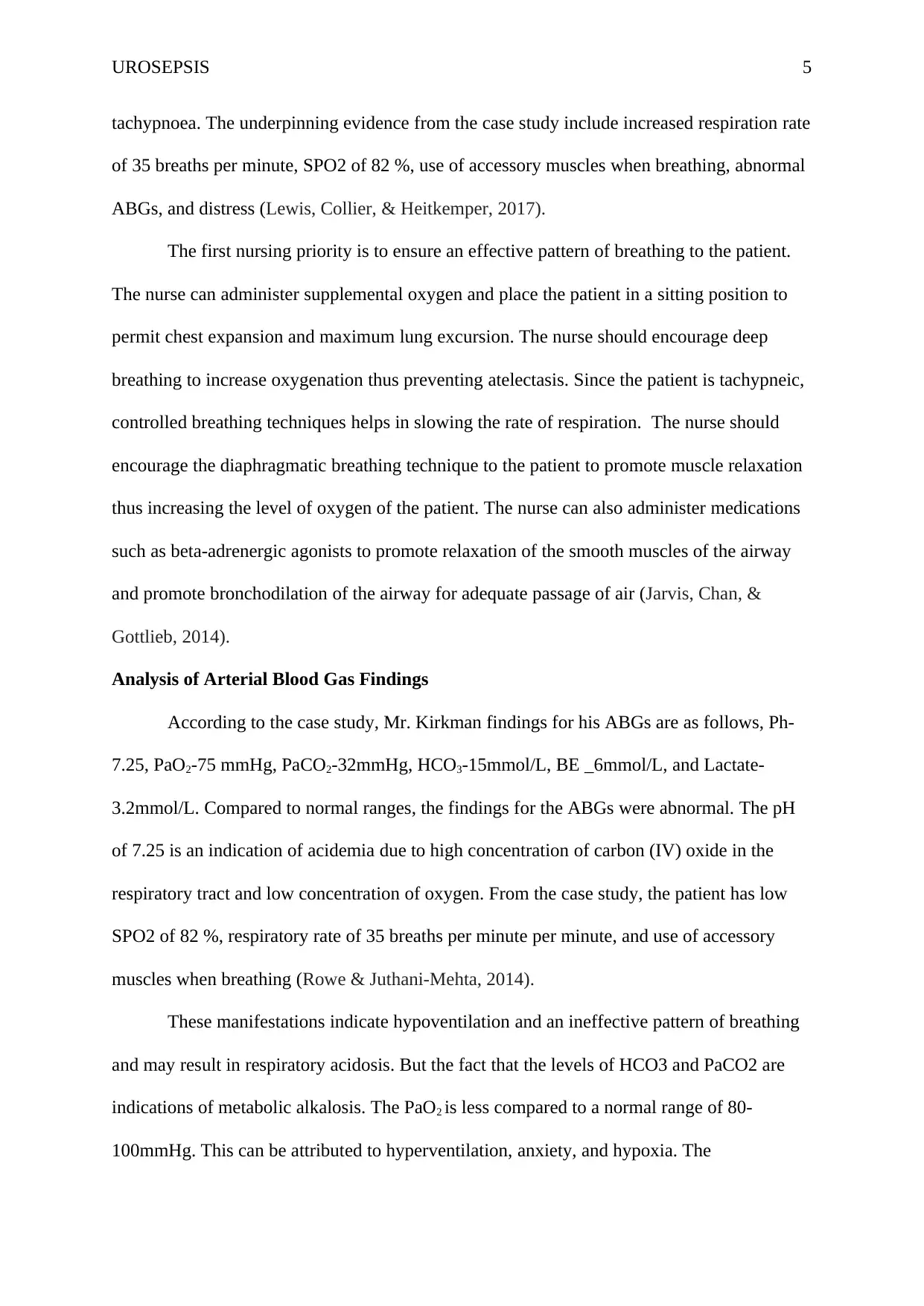
UROSEPSIS 5
tachypnoea. The underpinning evidence from the case study include increased respiration rate
of 35 breaths per minute, SPO2 of 82 %, use of accessory muscles when breathing, abnormal
ABGs, and distress (Lewis, Collier, & Heitkemper, 2017).
The first nursing priority is to ensure an effective pattern of breathing to the patient.
The nurse can administer supplemental oxygen and place the patient in a sitting position to
permit chest expansion and maximum lung excursion. The nurse should encourage deep
breathing to increase oxygenation thus preventing atelectasis. Since the patient is tachypneic,
controlled breathing techniques helps in slowing the rate of respiration. The nurse should
encourage the diaphragmatic breathing technique to the patient to promote muscle relaxation
thus increasing the level of oxygen of the patient. The nurse can also administer medications
such as beta-adrenergic agonists to promote relaxation of the smooth muscles of the airway
and promote bronchodilation of the airway for adequate passage of air (Jarvis, Chan, &
Gottlieb, 2014).
Analysis of Arterial Blood Gas Findings
According to the case study, Mr. Kirkman findings for his ABGs are as follows, Ph-
7.25, PaO2-75 mmHg, PaCO2-32mmHg, HCO3-15mmol/L, BE _6mmol/L, and Lactate-
3.2mmol/L. Compared to normal ranges, the findings for the ABGs were abnormal. The pH
of 7.25 is an indication of acidemia due to high concentration of carbon (IV) oxide in the
respiratory tract and low concentration of oxygen. From the case study, the patient has low
SPO2 of 82 %, respiratory rate of 35 breaths per minute per minute, and use of accessory
muscles when breathing (Rowe & Juthani-Mehta, 2014).
These manifestations indicate hypoventilation and an ineffective pattern of breathing
and may result in respiratory acidosis. But the fact that the levels of HCO3 and PaCO2 are
indications of metabolic alkalosis. The PaO2 is less compared to a normal range of 80-
100mmHg. This can be attributed to hyperventilation, anxiety, and hypoxia. The
tachypnoea. The underpinning evidence from the case study include increased respiration rate
of 35 breaths per minute, SPO2 of 82 %, use of accessory muscles when breathing, abnormal
ABGs, and distress (Lewis, Collier, & Heitkemper, 2017).
The first nursing priority is to ensure an effective pattern of breathing to the patient.
The nurse can administer supplemental oxygen and place the patient in a sitting position to
permit chest expansion and maximum lung excursion. The nurse should encourage deep
breathing to increase oxygenation thus preventing atelectasis. Since the patient is tachypneic,
controlled breathing techniques helps in slowing the rate of respiration. The nurse should
encourage the diaphragmatic breathing technique to the patient to promote muscle relaxation
thus increasing the level of oxygen of the patient. The nurse can also administer medications
such as beta-adrenergic agonists to promote relaxation of the smooth muscles of the airway
and promote bronchodilation of the airway for adequate passage of air (Jarvis, Chan, &
Gottlieb, 2014).
Analysis of Arterial Blood Gas Findings
According to the case study, Mr. Kirkman findings for his ABGs are as follows, Ph-
7.25, PaO2-75 mmHg, PaCO2-32mmHg, HCO3-15mmol/L, BE _6mmol/L, and Lactate-
3.2mmol/L. Compared to normal ranges, the findings for the ABGs were abnormal. The pH
of 7.25 is an indication of acidemia due to high concentration of carbon (IV) oxide in the
respiratory tract and low concentration of oxygen. From the case study, the patient has low
SPO2 of 82 %, respiratory rate of 35 breaths per minute per minute, and use of accessory
muscles when breathing (Rowe & Juthani-Mehta, 2014).
These manifestations indicate hypoventilation and an ineffective pattern of breathing
and may result in respiratory acidosis. But the fact that the levels of HCO3 and PaCO2 are
indications of metabolic alkalosis. The PaO2 is less compared to a normal range of 80-
100mmHg. This can be attributed to hyperventilation, anxiety, and hypoxia. The
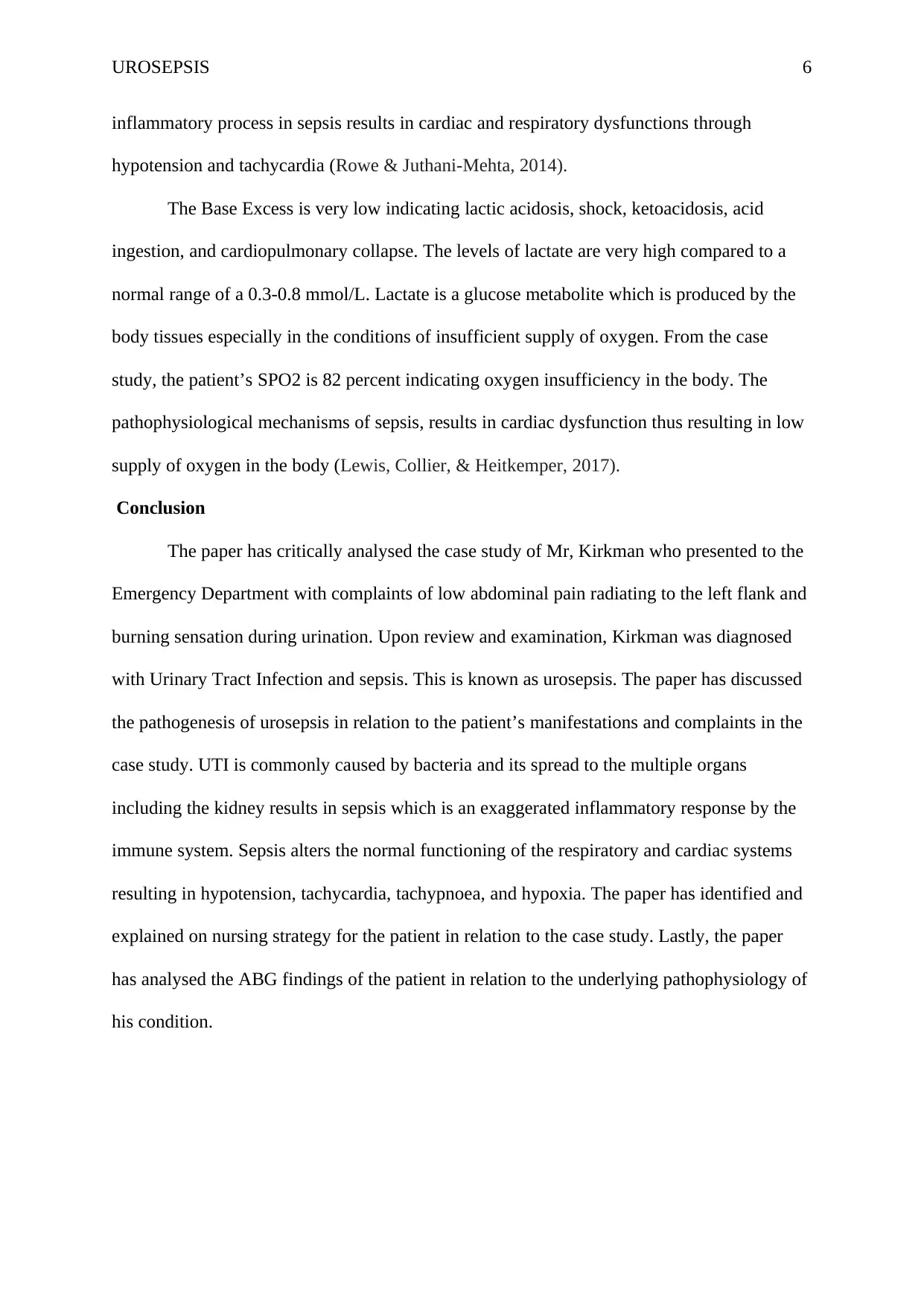
UROSEPSIS 6
inflammatory process in sepsis results in cardiac and respiratory dysfunctions through
hypotension and tachycardia (Rowe & Juthani-Mehta, 2014).
The Base Excess is very low indicating lactic acidosis, shock, ketoacidosis, acid
ingestion, and cardiopulmonary collapse. The levels of lactate are very high compared to a
normal range of a 0.3-0.8 mmol/L. Lactate is a glucose metabolite which is produced by the
body tissues especially in the conditions of insufficient supply of oxygen. From the case
study, the patient’s SPO2 is 82 percent indicating oxygen insufficiency in the body. The
pathophysiological mechanisms of sepsis, results in cardiac dysfunction thus resulting in low
supply of oxygen in the body (Lewis, Collier, & Heitkemper, 2017).
Conclusion
The paper has critically analysed the case study of Mr, Kirkman who presented to the
Emergency Department with complaints of low abdominal pain radiating to the left flank and
burning sensation during urination. Upon review and examination, Kirkman was diagnosed
with Urinary Tract Infection and sepsis. This is known as urosepsis. The paper has discussed
the pathogenesis of urosepsis in relation to the patient’s manifestations and complaints in the
case study. UTI is commonly caused by bacteria and its spread to the multiple organs
including the kidney results in sepsis which is an exaggerated inflammatory response by the
immune system. Sepsis alters the normal functioning of the respiratory and cardiac systems
resulting in hypotension, tachycardia, tachypnoea, and hypoxia. The paper has identified and
explained on nursing strategy for the patient in relation to the case study. Lastly, the paper
has analysed the ABG findings of the patient in relation to the underlying pathophysiology of
his condition.
inflammatory process in sepsis results in cardiac and respiratory dysfunctions through
hypotension and tachycardia (Rowe & Juthani-Mehta, 2014).
The Base Excess is very low indicating lactic acidosis, shock, ketoacidosis, acid
ingestion, and cardiopulmonary collapse. The levels of lactate are very high compared to a
normal range of a 0.3-0.8 mmol/L. Lactate is a glucose metabolite which is produced by the
body tissues especially in the conditions of insufficient supply of oxygen. From the case
study, the patient’s SPO2 is 82 percent indicating oxygen insufficiency in the body. The
pathophysiological mechanisms of sepsis, results in cardiac dysfunction thus resulting in low
supply of oxygen in the body (Lewis, Collier, & Heitkemper, 2017).
Conclusion
The paper has critically analysed the case study of Mr, Kirkman who presented to the
Emergency Department with complaints of low abdominal pain radiating to the left flank and
burning sensation during urination. Upon review and examination, Kirkman was diagnosed
with Urinary Tract Infection and sepsis. This is known as urosepsis. The paper has discussed
the pathogenesis of urosepsis in relation to the patient’s manifestations and complaints in the
case study. UTI is commonly caused by bacteria and its spread to the multiple organs
including the kidney results in sepsis which is an exaggerated inflammatory response by the
immune system. Sepsis alters the normal functioning of the respiratory and cardiac systems
resulting in hypotension, tachycardia, tachypnoea, and hypoxia. The paper has identified and
explained on nursing strategy for the patient in relation to the case study. Lastly, the paper
has analysed the ABG findings of the patient in relation to the underlying pathophysiology of
his condition.
⊘ This is a preview!⊘
Do you want full access?
Subscribe today to unlock all pages.

Trusted by 1+ million students worldwide
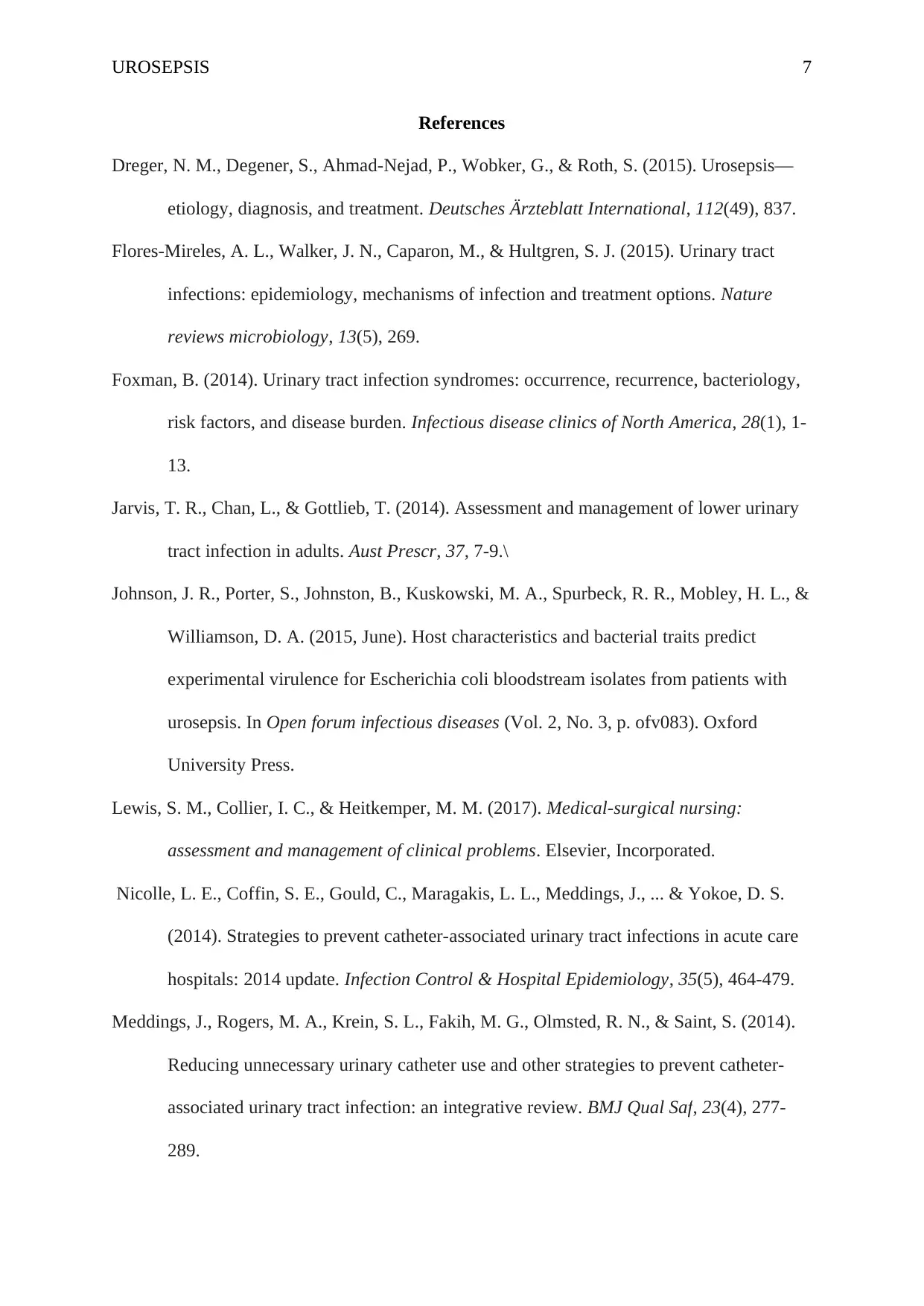
UROSEPSIS 7
References
Dreger, N. M., Degener, S., Ahmad-Nejad, P., Wobker, G., & Roth, S. (2015). Urosepsis—
etiology, diagnosis, and treatment. Deutsches Ärzteblatt International, 112(49), 837.
Flores-Mireles, A. L., Walker, J. N., Caparon, M., & Hultgren, S. J. (2015). Urinary tract
infections: epidemiology, mechanisms of infection and treatment options. Nature
reviews microbiology, 13(5), 269.
Foxman, B. (2014). Urinary tract infection syndromes: occurrence, recurrence, bacteriology,
risk factors, and disease burden. Infectious disease clinics of North America, 28(1), 1-
13.
Jarvis, T. R., Chan, L., & Gottlieb, T. (2014). Assessment and management of lower urinary
tract infection in adults. Aust Prescr, 37, 7-9.\
Johnson, J. R., Porter, S., Johnston, B., Kuskowski, M. A., Spurbeck, R. R., Mobley, H. L., &
Williamson, D. A. (2015, June). Host characteristics and bacterial traits predict
experimental virulence for Escherichia coli bloodstream isolates from patients with
urosepsis. In Open forum infectious diseases (Vol. 2, No. 3, p. ofv083). Oxford
University Press.
Lewis, S. M., Collier, I. C., & Heitkemper, M. M. (2017). Medical-surgical nursing:
assessment and management of clinical problems. Elsevier, Incorporated.
Nicolle, L. E., Coffin, S. E., Gould, C., Maragakis, L. L., Meddings, J., ... & Yokoe, D. S.
(2014). Strategies to prevent catheter-associated urinary tract infections in acute care
hospitals: 2014 update. Infection Control & Hospital Epidemiology, 35(5), 464-479.
Meddings, J., Rogers, M. A., Krein, S. L., Fakih, M. G., Olmsted, R. N., & Saint, S. (2014).
Reducing unnecessary urinary catheter use and other strategies to prevent catheter-
associated urinary tract infection: an integrative review. BMJ Qual Saf, 23(4), 277-
289.
References
Dreger, N. M., Degener, S., Ahmad-Nejad, P., Wobker, G., & Roth, S. (2015). Urosepsis—
etiology, diagnosis, and treatment. Deutsches Ärzteblatt International, 112(49), 837.
Flores-Mireles, A. L., Walker, J. N., Caparon, M., & Hultgren, S. J. (2015). Urinary tract
infections: epidemiology, mechanisms of infection and treatment options. Nature
reviews microbiology, 13(5), 269.
Foxman, B. (2014). Urinary tract infection syndromes: occurrence, recurrence, bacteriology,
risk factors, and disease burden. Infectious disease clinics of North America, 28(1), 1-
13.
Jarvis, T. R., Chan, L., & Gottlieb, T. (2014). Assessment and management of lower urinary
tract infection in adults. Aust Prescr, 37, 7-9.\
Johnson, J. R., Porter, S., Johnston, B., Kuskowski, M. A., Spurbeck, R. R., Mobley, H. L., &
Williamson, D. A. (2015, June). Host characteristics and bacterial traits predict
experimental virulence for Escherichia coli bloodstream isolates from patients with
urosepsis. In Open forum infectious diseases (Vol. 2, No. 3, p. ofv083). Oxford
University Press.
Lewis, S. M., Collier, I. C., & Heitkemper, M. M. (2017). Medical-surgical nursing:
assessment and management of clinical problems. Elsevier, Incorporated.
Nicolle, L. E., Coffin, S. E., Gould, C., Maragakis, L. L., Meddings, J., ... & Yokoe, D. S.
(2014). Strategies to prevent catheter-associated urinary tract infections in acute care
hospitals: 2014 update. Infection Control & Hospital Epidemiology, 35(5), 464-479.
Meddings, J., Rogers, M. A., Krein, S. L., Fakih, M. G., Olmsted, R. N., & Saint, S. (2014).
Reducing unnecessary urinary catheter use and other strategies to prevent catheter-
associated urinary tract infection: an integrative review. BMJ Qual Saf, 23(4), 277-
289.
Paraphrase This Document
Need a fresh take? Get an instant paraphrase of this document with our AI Paraphraser

UROSEPSIS 8
Peach, B. C., Garvan, G. J., Garvan, C. S., & Cimiotti, J. P. (2016). Risk factors for urosepsis
in older adults: a systematic review. Gerontology and geriatric medicine, 2,
2333721416638980.
Rowe, T. A., & Juthani-Mehta, M. (2014). Diagnosis and management of urinary tract
infection in older adults. Infectious disease clinics of North America, 28(1), 75.
Peach, B. C., Garvan, G. J., Garvan, C. S., & Cimiotti, J. P. (2016). Risk factors for urosepsis
in older adults: a systematic review. Gerontology and geriatric medicine, 2,
2333721416638980.
Rowe, T. A., & Juthani-Mehta, M. (2014). Diagnosis and management of urinary tract
infection in older adults. Infectious disease clinics of North America, 28(1), 75.
1 out of 8
Related Documents
Your All-in-One AI-Powered Toolkit for Academic Success.
+13062052269
info@desklib.com
Available 24*7 on WhatsApp / Email
![[object Object]](/_next/static/media/star-bottom.7253800d.svg)
Unlock your academic potential
Copyright © 2020–2025 A2Z Services. All Rights Reserved. Developed and managed by ZUCOL.





